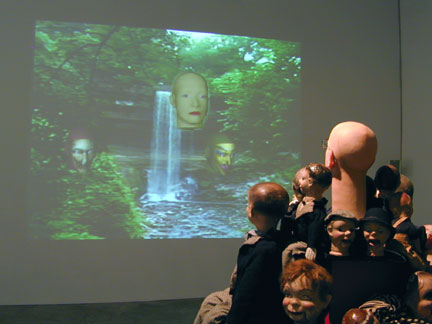Ken Feingold is an artist whose work has explored the communicative capacity of video installation, web-based programming, and "cinematic sculpture." Feingold is a recipient of awards from the National Endowment for the Arts, the John Simon Guggenheim Memorial Foundation, and was a recipient of a Rockefeller Foundation Media Arts Fellowship. His work is currently on view in the Grossman Gallery at the School of the Museum of Fine Arts.
-----
MG: What led you to into animatronic sculpture and installation?
KF: Well, I was very interested in speaking characters that weren’t fixed in their speech. I worked a little bit with actors, and worked a little bit with putting words into people’s mouths through overdubbing and things like that with videotape. Also, I had done some interactive things where you could change the sequence of playback of scenes. But, I wanted to get to where there was a more variable way to put language into the work that wasn’t written in advance, but that was attached to a human being, or something like a human being. It started with a piece that I did in 1993, with these little robots that were all connected together over the Internet. They had video camera in each of their heads and the idea was that you could connect from anywhere in the world and use the robot as your puppet and talk to people who were connected to the other puppet. It became clear rather quickly that there was a time zone problem, or there was just an interest level problem. So, I wanted to make robots that could know if there was someone connected to them or not, and if not, have software drive their conversational abilities. Otherwise, the piece wouldn’t really work if you were the only one there; I started thinking about what the precedents were in computing for doing that.
I got very interested in something that is referred to as the Eliza effect, which is this notion that even if you make a very simple, predictable kind of computer program, people will still suspend their sense of disbelief and try to talk to it, and try to project a personality into it. (Joseph Weizenbaum made an early conversational program he called Eliza). People would continue conversations way beyond where they would reasonably realize it’s just a program, there’s nobody there. That interested me very much and I started to make pieces that you could have conversations with. I found that the conversations that the visitors in the gallery were having were more of what those visitors were interested than what I wanted to put into the piece. I wanted to give these characters personalities, yet I didn’t want them to be able to talk about just anything at all, open-ended. I wanted them to try to steer the conversation. It was never as interesting for somebody just walking into the piece as it was for people to see me talking with it. And since I didn’t want them to be performance pieces that depended on me, I started to make pieces that had more than one character, so they could talk to each other. At that point, I decided to push the viewer participation out and start to make more dramatic interactions between the characters in the work. I started to think about them more as scenes where the parameters were described and the general topic of the conversation was described, but I wanted to allow the variability within it, so that when someone new came to hear what was said, it was somewhat different every time. And yet, not so different that it was a different work. Now, how do you make something that someone could see for one minute or two minutes and get the nature of the work, or something where somebody that would stay for 30 minutes or 3 hours or have it in their house and still continue to be fresh in some way and reveal new things about itself? That brought me into more complicated kind of programming that required examining, on a deeper level, a nature of thought in relation to language was and how to reorganize thoughts around the familiar language of habitual speech.
MG: Does the Eliza effect have to do with a Pygmalion reference in your work?
KF: Somebody pointed that out to m that there was this connection. Though, I never thought of it like that. For me, it came more out of ventriloquism, than out the transformation of a person in to some other person or to transform a sculpture into a living thing. It was more an ability to project a personality into something. I was very interested, for example, in the psychoanalytic notion of projection where you take something and put it into somebody else. And then you attribute to them these qualities that are a part of you. In the history of ventriloquism there’s been the puppet that could say things that the ventriloquist couldn’t that the ventriloquists wouldn’t want to say by themselves. That way the puppet could be the bad object and take the brunt of the audience dislike. And then the ventriloquist could be the one to say,” Oh, ‘isn’t he rude” or “can you believe that he said that?” And yet be the one who was saying it themselves. And yet, there is this kind of deflection away from the artist into the puppet, but the artist obviously being the art of creation.
MG: Though the puppets are animatronic, and very technologically present, the lineage to the sculpted body of the ventriloquist dummy is still very clear. In addition to the language exchange, there is the level of finish, which is to establish the setting though never fully renders the space that presents the action.
KF: Yes, absolutely. They don’t have animatronic realism the way that some of the Disney things might, where there’s many, many different muscle movements in the face. Here the jaw just opens and closes like a ventriloquist puppet. It’s done to foreground the artificiality of it. People see all kinds of things in it, because people want to identify with them. I think it’s that identification that I like to employ to make the work function. For example in the piece, “You”, people really relate to that because they identify with the characters, not because they ultra realistic, but because they are realistic enough to get them in to point where them into the mental territory of where it is. I see them as cinematic. I think about them literally as cinematic sculptures.
But, there’s a quality of sculpture that they have which is materially specific. They aren’t abstract things, nor are they things in themselves that just “ are what they are”. They are particular things. They are things rather than sculptures. “In Animal Vegetable and Mineralness of Everything”, that thing which is the sculpture is the object of discussion. They don’t recognize things that aren’t things, and all the parts and pieces of the works are made up of things, they aren’t invented forms. So, for me those things have signification that are culturally bound to things that people can name. Therefore, they can be can made meaningful because they are familiar and they collide and that’s what works within the space of cinema, you get all this stuff in the frame and you can say well this is a room and that is a desk and there is a person sitting there and that is a bed and that is a lamp and those things through their familiarity start to make the narrative work. So, I am relying on certain interpretations through a shared grammar of familiar objects and that is something I think which cinema and theatre both use. The reason that I don’t think about them so much as theatre is that I am not using that separation between the stage and the audience the way that theatre does. Some people have tried to break that down, but still when you think about theatre, even if it is not proscenium stage, you still think about the notion of onstage and offstage in a way. And these works, as you said, when you went to the space, you are in the space of the work. The work commands the space that it’s in and you don’t know if you’re activating it or you’re participating in it or where to situate your physical body in relation to it. So, in a way, it is like the mental space of being in a movie. You’re there voyeuristically. Sometimes in more Brechthian kind of cinema, you feel yourself heavily sitting in the chair, aware of your position as a voyeur in the audience, but most cinema that you really are taken into, you lose that sense of voyeur situated in space. You are projecting you’re mind into the scene somewhere.
MG: What is interesting to me is that when walking into the space, you lose having that surety of reflection to base your identity, suddenly being unsure of what it is you are seeing. You lose that extension of not being able to reflect and define a spot for yourself with that feedback.
KF: They do have that quality. It’s their uncanniness. Freud pointed out that feeling, that notion of uncanniness, opens a gap between what is ordinarily feeling with what is quite comfortable as being day to day life, those things you perceive as being out of control or as disorder, things that are driving you that you don’t know about. I do use that power as a kind of raw material in the work, although its not for the purpose of shocking people or just getting them upset, but there is something about the recognition that these are like human; they look like humans and they act like humans, but no human no human could possibly be in that form, and yet also playing off that popular imagery that we have from like science fiction where you have these heads connected to tubes and wires and still they’re talking, but kept alive by some myth in the popular culture that human beings exist in the head and you can still take away the rest of it and you’ll still have a person there.
MG: Yet, there is no attempt at phantasmagoria, any attempt to conceal the means of producing the effect of what it does. There is one level of finish, which is the primary focus, and then there is all of this intermediary support, which helps accentuate that uncanniness, it’s like witnessing a surgery where the patient is still awake. The questions always come up: “Can I walk around it?” “Can I look at the back?” “Is this in progress of being put together?”
Through the work, we can vent our frustration that stems out of our own powerlessness to speak. To create this likeness, to put it out there in some way, to have this catharsis of working through something, and watching how that frustration can be turned into something creative.
KF: I think there is a kind of catharsis when they actually have the kinds of conversations that I want them to have. There is so much energy invested in getting them to that point and writing their language and their programs and creating their physicality. When it actually runs and they are the way I want them to be, I feel like I’ve gotten that cathartic experience. The tension having created through the process of making the work and then having that tension released once seeing them do it on their own. I don’t know if it is necessarily getting the cause of that tension out of me permanently or just allowing me to see it in front of me so that I can confront it differently, or like you said, hold it in regard in front of you in order to work it out on your own.
MG: Hillel Schwartz wrote, in part, in the book The Culture of the Copy, about this aspect of our culture which is obsessed with making copies to keep and maintain information in the long term, either bodily, through types of mummification and automata, or in bodiless reproductions like sound recording. What do you think about our culture’s dedication to reproducing, with great fidelity, the best sorts of virtual reality objects?
KF: I don’t think about the notion of - people like Moravec at Carnegie Mellon who were talking about uploading personalities into artificial bodies and William Gibson’s notion of that in his work - that somehow there was a kind of technological destiny that human beings were working to achieve so they could achieve immortality by putting themselves into it.
What I think is really the issue is that people create all these technologies in order to understand themselves. The creation of artificial intelligence means understanding what intelligence is, and it transformed into an investigation of cognitive science of: What is cognition? What is intelligence? It is not such an easily answered question. At a certain point, people thought the brain is just performing a lot of calculations. And then, you look back at the last generation of technology served as the previous metaphor, “Well, it’s just like a clockwork mechanism - the brain is just like x, y, and z.” So, I think it’s putting the cart in front of the horse, where in fact we create these technologies so that we can look at ourselves and figure out how we work and who we are, what we’re after and then as soon as we start to see something seminal emerging and growing out of it, we realize, well that wasn’t the right question, but it’s taken me to the next question. So, I don’t see these pieces as being any kind of continuation of myself in the future as much as or any more than any artwork, there is some kind of a thing that you created which takes your ideas through a certain process and then remains as a kind of trace of that process, and hopefully intersects somebody else in the traces of their process of their life that it is going to be meaningful to them in someway and enhances in someway their questions about what they’re up to and what they’re after and what they’re thinking about. I don’t think about them as being beings or life or anything like that. They’re less than actors, they’re really robots and they are just doing what they’re programmed to do and they surprise me and I like that about them, but it’s programmed in kind of surprises. Sometimes things happened that I hadn’t imagined, and that is very nice, but sometimes I have to take them out because it doesn’t have anything to do with that piece, so having that power, it is quite odd, and I see just raising my daughter, where that is not something that parents do. You encourage someone and you give someone energy and you nurture them and you provide for them to have a great environment to become who they are, but you can’t take something out of them unless you are really a monster and they are going to get interested in the things that they’re interested in depending on what they encounter and what you encourage, etc., but if they have a certain personality characteristic, you can’t reprogram it. Or, if you attempt to do that, you’re really going to traumatize them. And, also the fact, that it could take me years and years and years to learn how to program what any 3 month old is capable of learning. That level of sophistication, of being able to grasp something, look at it from all sides and then be able to recognize it from across the room the second time that they see it, it is not an easy thing to teach a computer to do. I mean, people have learned how, but it is certainly not rudimentary, and what I am doing is much more about habitual thinking and associative pattern-making than the kind of things that we do, which are almost not thinking at all. They’re more like working on automatic. It’s these kinds of things that are happening in your field of consciousness that are character patterns.
MG: The sculptures you have in the gallery don’t just perform acts for the sake of doing it. What I mean by that is, they don’t perform a specific function like robots in the research labs at MIT, where they were created and programmed to test a very specific aspect of the design they were intended to perform. You have made your creations such that they perform beyond the utilitarian and have a character creating a space where they can have these existential conversations - that is quite sophisticated.
KF: The utilitarian aspect is what makes it possible. For example, Lacan said something very enigmatic, which was that the unconscious was structured like a language and its pretty hard to understand what that means until you think about how language is really structured – like lists, syntax and such as these are adjectives, these are nouns, these are color words. You start thinking about how, if you just have certain patterns, and those patterns can be drawn out of these things that can be described more broadly, and then certain things through repression, not allowable and other ones through reinforcement, become the kind of person that you are at any one moment. It’s almost a utilitarian thing, to create something that seems like a personality. And, to me, what that teaches us is that if we really want to get at a personality, you’ve got to work at it. You can work on automatic without really working at all and still act like a person, but you are sort of walking around dead, with no real emotion, no real feeling about things. Like, first impressions, people value them, they remember them, but they forget to keep having first impressions. Everybody has the experience of going someplace for the first time and finding it really magical and then you go back there another time and it seems like, “Oh, well, we’ve been here.” But to see the way the see it the way you saw it before you had any preconception, that’s pretty good. And then to see it more raw than that, even better.
MG: Have you or did you read or watch a lot of science fiction in the past?
KF: No, not really. I’ve read some. There were some people I was interested in for a while. I like Rudy Rucker’s writing a lot; I think he’s a real original character. And I like Gibson’s stuff. I tend to read other fiction writers. Ones I’ve liked a lot are Borges, William Burroughs, and Octavio Paz, whose work is very powerful for me, this territory between fiction and essay and poetry. Where it’s how you turn experience into language and how internal dialogue that we have with our experience creates the next moment of experience and how that carries you through to the next moment of the experience and how that carries you through the world and how this overlay of interior world and what’s going on outside.
But, sci-fi is full of fascinating people, though the work is uneven. But I find some, like Samuel Delaney and some of his work like the book Dahlgren – what an original. He’s such an unusual person. So I think that what remains is for someone to do an encyclopedia or a group of biographies of science fiction writers.
Links:
Ken Feingold.com
The School of the Museum of Fine Arts
"Ken Feingold: New Works" is on view until October 23 at the Grossman Gallery of The School of the Museum of Fine Arts (230 The Fenway, near the MFA and Gardner).
All images are courtesy of the artist
Matthew Gamber is the executive editor of Big, Red & Shiny.




